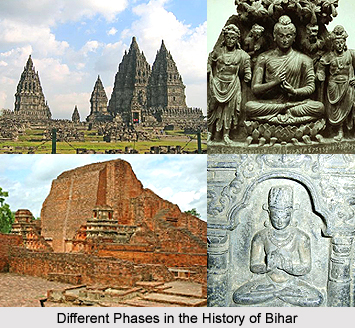Ancient history of Bihar is very ancient. It expands to the very dawn of human civilization. Ancient Bihar, known as Magadha, was the center of power, learning, and culture in India for 1000 years.
Legends of Bihar
Earliest myths and legends of Hinduism the Sanatana (Eternal) Dharma - are associated with Bihar. Sita, the consort of Lord Rama, was a princess of Bihar. She was the daughter of King Janak of Videha. The present districts of Muzaffarpur, Sitamarhi, Samastipur, Madhubani, and Darbhanga, in north-central Bihar, mark this ancient kingdom. The present small township of Sitamarhi is located here. According to legend, the birthplace of Sita is Punaura, located on the west-side of Sitamarhi, the headquarters of the district. Janakpur, the capital of King Janak, and the place where Lord Rama and Sita were married, lies just across the border in Nepal. It is reached via the rail station of Janakapur Road located in the Sitamarhi district, on the Narkatiyaganj - Darbhanga section of the North-Eastern Railway.

Early Dynasties of Bihar
Bihar has been ruled by different dynasties and mighty rulers. Few of the dynasties that ruled Bihar are discussed below:
Sixteen Mahajanapadas
The literal meaning of Mahajanapadas is great kingdoms. They flourished in the north/north western parts of India before the rise of Buddhism. Aryans have migrated into India long time back and there were regular friction between them and the non Aryan tribes concerning, cattle, fodder, land etc. Sixteen great kingdoms as they are referred to by buddhist and other texts. The sixteen mahajanapadas include Kasi, Kosala, Anga, Magadha, Vajji, Malla, Chedi, Vatsa, Kuru, Panchala, Machcha, Surasena, Assaka, Avanti, Gandhara and Kamboja. They stretched their kingdoms from the Indo-Gangetic plains from modern-day Afghanistan to Bengal and Maharastra. Anga and Magadha is the modern North Bihar and South Bihar respectively.
Magadha
In ancient times Magadha was an important city of India because it was the centre of cultural change. It was the seat of the Brihadratha dynasty, Pradyota dynasty, Shishunaga dynasty, Nanda Dynasty, Maurya Empire, Sunga Empire, Kanva Dynasty and the Gupta Empire. Magadha formed one of the Sixteen Mahajanapadas or regions in ancient India. Magadha covers the portion of Bihar lying south of the Ganges, with its capital at Rajgir. With the conquest of Licchavi Tribe and Anga, the kingdom of Magadha expanded to include Bihar and Bengal. The capital of Magadha was Rajgir but in the later ages the capital of Magadha was Pataliputra.
Gupta Empire
The Gupta Empire ruled from around 240 to 550 AD. India witnessed peace and prosperity under the Gupta Empire. This period was marked by extensive achievements in science, dialectic, literature, logic, mathematics, astronomy, technology, engineering, art, religion and philosophy. The Chinese traveler Hieun-Tsang had provided the first evidence of the Gupta kingdom in Magadha. The Gupta period was known as the "Golden Age." The rulers of the Gupta period were Chandragupta Maurya, Samudra Gupta, Chandragupta II, Skanda Gupta and others.
Pala Dynasty
The Pala Dynasty of India originated after the death of Sasanka in Bengal. This dynasty reined the Indian states of Bihar and Bengal from 8th to the 12th century. According to the medieval history of India, the Palas rescued Bengal from this disorder. The founder of the Pala dynasty was Gopala who ruled from 750-770. His successor, Dharmapala ruled from 770-781 and made the dynasty a dominant power of northern India. This dynasty is acknowledged as the Palas because all the rulers had their last names as "Pala" which means protector. Pala Empire was the last empire of middle kingdoms whose capital was Patliputra (modern Patna).



















